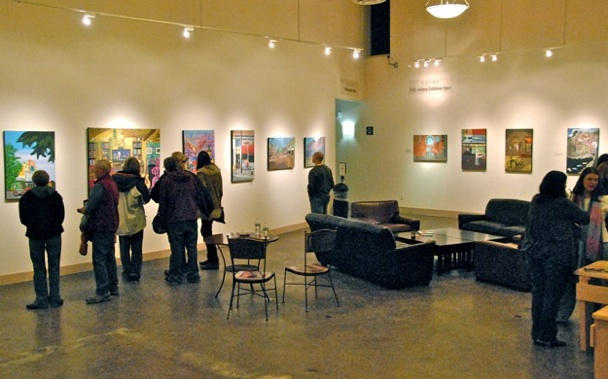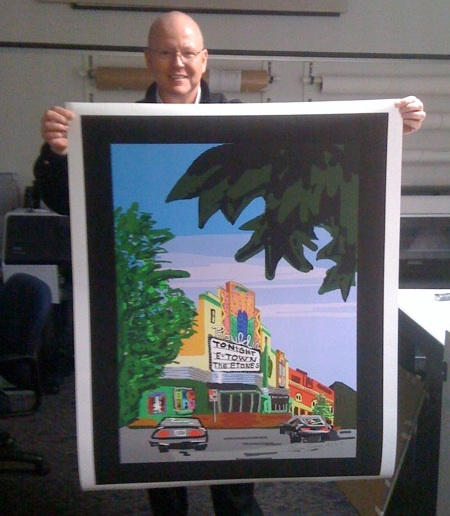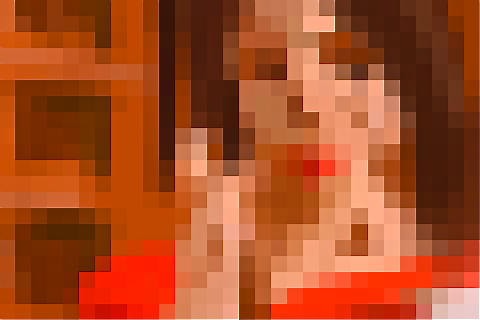Back in 2008, after looking at photographer Russ Croop’s paintings ably done using the NetSketch and Brushes apps on his iPhone, we wondered how long it would take before this form of fancy finger work hung in art galleries. (An exhibit of fellow fingerpainter Matthew Watkins took place at an Italian Apple reseller in September).
Fast forward 13 months: Croop has a one-man show of 15 works called “Painting Through a Keyhole: the iPhone as Canvas” at the The Dairy Center for the Arts in Boulder, Colorado until February, 12, 2010 and participated in the international offerings at “iPhone Therefore I Am” at the Chicago Art Department that also launched Jan. 8.

Cult of Mac talked to Croop about how he got from iPhone touchscreen to art gallery, the mistakes he made — that every iPhone artist should avoid — and the misunderstandings most gallery goers have when they see his work.
CoM: How did the show come about?
Russ Croop:
The Dairy Center for the Arts has three galleries and hosts different art shows almost every month…It’s supposed to be a pretty exacting juried selection process with several judges from different disciplines. They use a high-tech projector system that times each image so every picture gets equal billing. I submited my iPhone paintings last April 2009 and didn’t find out that I was selected until October 2009.
CoM: How did you decide on the title and theme?
RC: I often compare creating art on the iPhone to painting through a keyhole because when you zoom in to add detail, you can only see a small portion of the “canvas.” This is especially true when using NetSketch.

Imagine an oil painter trying to paint a 50″ x 50″ canvas but being forced to paint through a rectangular opening that is 2″ x 3″ in size. S/he could paint the canvas behind that small rectangle but would have to peer through the tiny opening to see the entire canvas, then move the hole and paint some more…
I am also fascinated with images that exist somewhere between photography and painting. My favorite compliment is when someone says that my photographs look like paintings.
Conversely, many say my iPhone paintings look like photographs. This caused a bit of confusion. Some people at the opening thought that I somehow manipulated a photograph to create the images. I explained that I usually just pull up a photograph on my computer screen and then sit in front of the screen and, starting with a blank canvas, finger paint the scene on my iPhone.
CoM: How did you get the paintings from your iPhone to canvas?
RC: Most iPhone painting applications feature a way to transfer the image from the iPhone to the computer. Brushes has you connect via wi-fi and then a viewer appears lets you create various sized files and Quicktime movies. Here’s a screenshot of the Brushes Viewer:
Once the painting is on the computer, I open it in Photoshop and make sure the exposure and color look good. I can then resize it to fit whatever sized print I want to make.
I had our local photography lab, Mike’s Camera, print the paintings on canvas and do what they call a “gallery wrap” so that the edges of the canvas wrap around a wooden frame. I printed the images with a black border so that the edges would be black. I also didn’t want my signature to end up hidden on the bottom edge because, let’s face it, the artist’s signature is the most important part of the painting. I put all full-sized images on a DVD, delivered it to Mike’s and they did the rest. Here is John from Mike’s holding up the first giclee archival print “Boulder Theater” to come off the printer:
CoM: This was your first iPhone gallery show. What would you do differently next time?
RC: It was really interesting to see the paintings printed so large. The first thing I noticed was the mistakes. Unpainted spaces became really obvious. There were some random strokes caused when I tried to use the pinch motion to resize and it made a long stroke, but I didn’t notice them on the small screen. The faces on some of the figures looked really weird. Since Brushes is a raster based application, the more you zoom in, the more pixelated the image becomes. It’s almost impossible to add just one pixel when zoomed in at 1600% because if you touch the screen just once, it brings up the menus. You have to sort of slowly drag your finger across the screen the slightest bit and hope the stroke isn’t too big.
The first image is a screenshot from my iPhone of the girl’s face zoomed in to 1600%. That is exactly what it looks like while I’m painting on the screen when completely zoomed in:
.
The second image is what the girl’s face looks like when it is printed. You can imagine my surprise when I unwrapped the 24″x36″ glicee and saw this! She looks like Michael Jackson on a bad day. Yikes! Freaky, freaky.
CoM: Prices?
RC: “My Living Room,” the largest iPhone painting in the world, printed at 42″ x 50″ is priced at a modest $650. All others were printed at around 24″ x 36″ and priced at $450 each.
I also have many other sizes available. They can be printed on almost anything: canvas, photographic paper, textured watercolor paper and I’m getting ready to make some into sets of greeting cards. They can be printed on t-shirts, rugs, messenger bags, coffee mugs, jigsaw puzzles, a 16 month calendar and even a deck of playing cards…
I’ll let you know if anything sells. So far, no nibbles.






